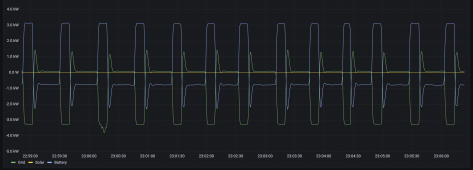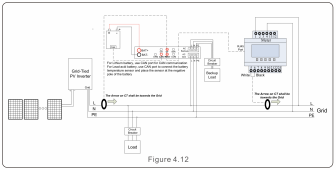Hello folks,
Noob here though hoping there's a bit more of a knowledge base than some of the other forums!
Background - I already have 4kWP of PV on a SolarEdge inverter and picked up the Solis RAI AC-coupled with a view to using 48V of leisure batteries that I originally had for a UPS.
The Solis is installed and claiming to be operational but seemingly never discharges and hence contribute to the household loads. I have 3 lines of thinking why
1. It doesn't like the battery config (I have a US5000 on pre-order but this was a stop gap)
2. Settings - I'm sure anyone with a Solis will agree it's clunky and the TechView app is next to useless (no installer password it seems?)
3. CT input and algorithm not quite picking up the power flow and thus assuming everything is balanced
So here are some puzzlements that might help as the settings are a little bizarre:
I set up the batteries as per the 'Battery Select' menu and set the various volts/currents etc
I changed the Storage Energy Set>CT Install to PV Inverter (rather than grid) - this makes sense as it is clamped around the PV leg (though it overreads it seems) - the CT is directional and I have double checked this
Stg Mode Select>Self use - but has a hidden menu that allows access to the 'time of use' settings - so I disabled 'charge from grid', again no difference
Export Power Set>
EPM>On (export power management)
Backflow power (set to 0000W)
Failsafe>On (to comply with G100
So I can't figure out if it's due to me using Lead Acid batteries or that the way it is calculating the net power that the house is using is inaccurate - the Acrel meter seems to be pretty close to the nearest few Watts (again double checked orientation), but when I look in Information>System Info menu the 'grid power' doesn't seem to make sense - I would have assumed that it is using this value to figure out how much power to output...but it's not clear if a positive or negative value indicates import or export?
Any thoughts or experience of the quirks of the Solis welcomed - thanks!
Noob here though hoping there's a bit more of a knowledge base than some of the other forums!
Background - I already have 4kWP of PV on a SolarEdge inverter and picked up the Solis RAI AC-coupled with a view to using 48V of leisure batteries that I originally had for a UPS.
The Solis is installed and claiming to be operational but seemingly never discharges and hence contribute to the household loads. I have 3 lines of thinking why
1. It doesn't like the battery config (I have a US5000 on pre-order but this was a stop gap)
2. Settings - I'm sure anyone with a Solis will agree it's clunky and the TechView app is next to useless (no installer password it seems?)
3. CT input and algorithm not quite picking up the power flow and thus assuming everything is balanced
So here are some puzzlements that might help as the settings are a little bizarre:
I set up the batteries as per the 'Battery Select' menu and set the various volts/currents etc
I changed the Storage Energy Set>CT Install to PV Inverter (rather than grid) - this makes sense as it is clamped around the PV leg (though it overreads it seems) - the CT is directional and I have double checked this
Stg Mode Select>Self use - but has a hidden menu that allows access to the 'time of use' settings - so I disabled 'charge from grid', again no difference
Export Power Set>
EPM>On (export power management)
Backflow power (set to 0000W)
Failsafe>On (to comply with G100
So I can't figure out if it's due to me using Lead Acid batteries or that the way it is calculating the net power that the house is using is inaccurate - the Acrel meter seems to be pretty close to the nearest few Watts (again double checked orientation), but when I look in Information>System Info menu the 'grid power' doesn't seem to make sense - I would have assumed that it is using this value to figure out how much power to output...but it's not clear if a positive or negative value indicates import or export?
Any thoughts or experience of the quirks of the Solis welcomed - thanks!




